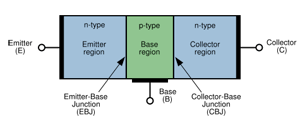Difference Between BJT and MOSFET

The transistors BJT and MOSFET are both useful for amplification and switching applications. Yet, they have significantly different characteristics.
BJT, as in Bipolar Junction Transistor, is a semiconductor device that replaced the vacuum tubes of the old days. The contraption is a current-controlled device where the collector or emitter output is a function of the current in the base. Basically, the mode of operation of a BJT transistor is driven by the current at the base. The three terminals of a BJT transistor are called the Emitter, Collector and Base.
A BJT is actually a piece of silicon with three regions. There are two junctions in them where each region is named differently ‘“ the P and N. There two type of BJTs, the NPN transistor and the PNP transistor. The types differ in their charge carriers, wherein, NPN has holes as its primary carrier, while PNP has electrons.
The operation principles of the two BJT transistors, PNP and NPN, are practically identical; the only difference is in biasing, and the polarity of the power supply for each type. Many prefer BJTs for low current applications, like for switching purposes for instance, simply because they’re cheaper.
Metal Oxide Semiconductor Field-Effect Transistor, or simply MOSFET, and sometimes MOS transistor, is a voltage-controlled device. Unlike the BJT, there is no base current present. However, there’s a field produced by a voltage on the gate. This allows a flow of current between the source and the drain. This current flow may be pinched-off, or opened, by the voltage on the gate.
In this transistor, a voltage on an oxide-insulated gate electrode can generate a channel for conduction between the other contacts ‘“ the source and drain. What’s great about MOSFETs is that they handle power more efficiently. MOSFETs, nowadays, are the most common transistor used in digital and analog circuits, replacing the then very popular BJTs.
Summary:
1. BJT is a Bipolar Junction Transistor, while MOSFET is a Metal Oxide Semiconductor Field-Effect Transistor.
2. A BJT has an emitter, collector and base, while a MOSFET has a gate, source and drain.
3. BJTs are preferred for low current applications, while MOSFETs are for high power functions.
4. In digital and analog circuits, MOSFETs are considered to be more commonly used than BJTs these days.
5. The operation of MOSFET depends on the voltage at the oxide-insulated gate electrode, while the operation of BJT is dependent on the current at the base.
- Difference Between Lymphoma and Leukemia - March 7, 2024
- Difference Between CP and CPK - June 8, 2010
- Difference Between PPTP and L2TP - June 7, 2010

Its amazing and it gave much info
The Provided information is quite good… but as a engineer i am looking for some more information eg Speed of operation/Construction Detail etc
i’ve been everywhere but only understood the differences here. great job.
good job
good explaination but i wanted the difference from a circuit analysis perspective !!
It was a good explaination but i want a d/b MOSFET, JFET AND BJT
Thanks for the intro to this subject
Welcome
Thanks, it helped a lot
Lucid information
Easy to relate
Can we pair a Darlington of transistor and MOSFET ?
can someone give me a quick summary about the different between them thank:)
Bjt operation is current dependent while Mosfet operation is voltage dependent.
Bjt is used for low current apps. Mosfet is used for hight power func.
Bjt has Base,emitter,collectot.Mosfet has Source,drain and gate.
Its a good explanation.. We want more dffrnce..
Was close but want to know if they can be used in place of transistors on circuit diagrams, which from what I gather elsewhere you can do…eg the collector is the gate ? source? obviously whichever one does the switching, bit baffled… : )
Gd and helpful Thank u. …
Nice
Thanks
super notes but extra word.